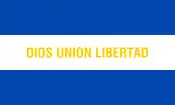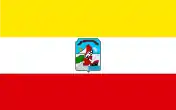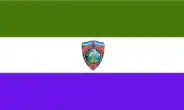 | |
| Bandera Magna (Magna flag) (in Spanish) | |
| Use | State and war flag, naval ensign |
|---|---|
| Proportion | 189:335,[1] approximately 9:16 |
| Adopted | 27 May 1912 |
| Design | A horizontal triband of cobalt blue (top and bottom) and white with the National Coat of Arms in the center and occupying the entire height of the white stripe with its top touching the upper blue strip and its base touching the lower blue stripe. |
 | |
| Use | Civil flag and ensign |
| Design | A horizontal triband of white within cobalt blue |
 | |
| Use | State and war flag, civil and state ensign |
| Design | A horizontal triband of white within cobalt blue, the words "DIOS UNION LIBERTAD" in bolden golden amber centered and occupying almost the entire length of the white stripe |
The flag of El Salvador features a horizontal triband of cobalt blue-white-cobalt blue, with the coat of arms centered and entirely contained within the central white stripe. This design of a triband of blue-white-blue is commonly used among Central American countries. El Salvador's flag is one of few that currently use the color purple, due to the rainbow in its coat of arms.
Features

.jpg.webp)


The colors signify:
- Golden Amber: represents the entire bold phraseology in the flag, the coat of arms of El Salvador; the bold equilateral triangle, 5 indigenous spears, beaming solar rays, scroll, the bold motto (God Union Liberty) and the bold etymology (Republic of El Salvador in Central America)
- The flag has the words (REPÚBLICA DE EL SALVADOR EN LA AMÉRICA CENTRAL) in a bold and Heavy, Sans Serif Boris Black Bloxx typeface, in a golden amber color
- The national motto (DIOS UNIÓN LIBERTAD) in Trajan bold Roman square capitals. The letter are colored amber gold on the civil flag, and black in the coat of arms
- The date (15 DE SEPTIEMBRE DE 1821) in Trajan bold Roman square capitals
The blue hue is a vivid, lustrous and luscious rich solid cobalt blue. In the center of and occupying the entire width of the white stripe is the coat of arms with its top touching the upper blue strip and its base touching the lower blue stripe. The coat of arms contains the in bold golden amber words "REPÚBLICA DE EL SALVADOR EN LA AMÉRICA CENTRAL" (English: Republic of El Salvador in Central America). There are two variant flags, one without the coat of arms, and the other with the words "DIOS UNIÓN LIBERTAD" (English: God, Union, Liberty) in bold golden amber in place of the coat of arms. All three contain the same cobalt blue and white stripes, occasionally with a gold Fringe (trim). The main flag has an aspect ratio of 189:335 while the variants are both 3:5.[2]
From 1865 to 1912, a different flag was in use, with a field of alternating cobalt blue and white stripes and a red canton containing stars. The designs of both sides of the flag are different; at the reverse side, it shows the then national coat of arms at the position of stars at obverse. The stars symbolized the provinces of the Republic; once a new province was created, one star was add to the obverse of the flag. This "Star-Striped" banner was considered to be inspired by the flag of the United States.
The blue stripes symbolize the ocean and sky. The white means Peace. Blue is an important color in Salvadoran culture and identity. It started with Native American cultures of Mesoamerica in El Salvador, that produced (añil) indigo plant which they used extracts to produce blue dyes. When the Europeans invaded and colonized the area, they saw the wealth of indigo and turned El Salvador to one of the world's foremost providers of indigo dye in its time.
Many other countries in Central America use blue and white colors as a Pan-Central American symbol.
Synonymous to the country's wealth, the colonizers referred to the dye as "the blue gold", that dominated El Salvador's economy until it was completely replaced by coffee cultivation. Today El Salvador remains as one of the few countries in the world that still cultivates indigo to produce blue dyes. Over time El Salvador's flag has had several different shades of blue, from the lightest to darkest, including Royal blue, Sapphire, Klein Blue and Indigo. The present current modern flag displays a cobalt blue color.
 President of El Salvador Nayib Bukele wearing the presidential sash with the national flag standing behind
President of El Salvador Nayib Bukele wearing the presidential sash with the national flag standing behind![The five rowed volcanos in the coat of arms were inspired by the Cordillera de Apaneca volcanic range when El Salvador's Sonsonate City was the second capital of the Federal Republic of Central America in 1834.]](../I/Salcoatit%C3%A1n%252C_El_Salvador_-_panoramio_(9).jpg.webp) The five rowed volcanos in the coat of arms were inspired by the Cordillera de Apaneca volcanic range when El Salvador's Sonsonate City was the second capital of the Federal Republic of Central America in 1834.]
The five rowed volcanos in the coat of arms were inspired by the Cordillera de Apaneca volcanic range when El Salvador's Sonsonate City was the second capital of the Federal Republic of Central America in 1834.] The first coat of arms which declared the country's citizens as Salvadorans
The first coat of arms which declared the country's citizens as Salvadorans
Departments
Historical flags of El Salvador
| Flag | Adopted | Relinquished |
|---|---|---|
 |
1525 | 1701 |
.svg.png.webp) |
1701 | 1760 |
.svg.png.webp) |
1760 | 1785 |
.svg.png.webp) |
1785 | 15 September 1821 |
| ??? | 15 September 1821 | 20 February 1822 |
 |
20 February 1822 | 9 February 1823 |
 |
9 February 1823 | 1 July 1823 |
 |
1 July 1823 | 22 November 1824 |
 |
22 November 1824 | February 1841 |
 |
February 1841 | 1842 |
 |
1842 | 1844 |
 |
1844 | 9 May 1865 |
.svg.png.webp) |
9 May 1865 | June 1865 |
.svg.png.webp) |
June 1865 | 1869 |
.svg.png.webp) |
1869 | 1873 |
.svg.png.webp) |
1873 | 1877 |
.svg.png.webp) |
1877 | 2 November 1898 |
_reverse.svg.png.webp) |
1877 (reverse) | 2 November 1898 (reverse) |
.svg.png.webp) |
2 November 1898 | 30 November 1898 |
.svg.png.webp) |
30 November 1898 | 17 May 1912 |
_reverse.svg.png.webp) |
30 November 1898 (reverse) | 17 May 1912 (reverse) |
 |
17 May 1912 | 1921 |
 |
1921 | 1922 |
 |
1922 | present |
References
- ↑ "Flag of El Salvador". Encyclopedia Britannica. Retrieved 2018-10-13.
- ↑
- Art.7. "La bandera magna será de tres metros treinta y cinco centímetros de largo por un metro ochenta y nueve centímetros de ancho, en la cual irá dibujado el Escudo de Armas con todos sus blasones." (The greater flag is 3m 35cm long and 1m 89cm wide and includes the entire national coat of arms)
- Art.9. "La bandera de uso en edificios y oficinas públicos, será de un metro de largo por sesenta centímetros de ancho (..) En la franja del centro llevará la leyenda: DIOS UNION LIBERTAD" (The flag for use at public buildings is 1m long by 60cm wide (..) The central stripe shall bear the inscription 'Dios Union Libertad')
- Art.11. "La bandera de desfiles deberá medir un metro cuarenta y cinco centímetros de largo por noventa centímetros de ancho (..) La franja blanca de la bandera para desfiles, llevará en letras doradas la inscripción: DIOS UNION LIBERTAD" (The flag for use at parades will be 1.45m long by 90cm wide (..) The white stripe of the flag for parades shall bear in golden letters the inscription 'Dios Union Libertad')




.svg.png.webp)




.svg.png.webp)



